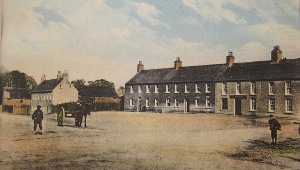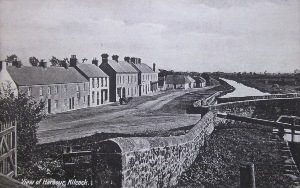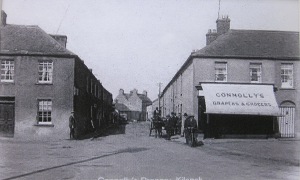A Short History of Commercial Activity
in Kilcock
Published in ‘Kilcock Business Association Directory 2010–2011’
Kilcock is noted as a major trading centre from as far back as the medieval period. In the late 12th century, when the Normans arrived in the area, they recognised the importance and potential of Kilcock as a trading centre. They built a substantial settlement within the ancient St. Coca’s ecclesiastical enclosure and laid out a market-place in the centre of the settlement. The dwellings were built around this market-place. Today the ‘Square’ in Kilcock is on the site of this ancient market-place and still retains the same streetscape of the early settlement. An early description of the Town describes it as having ‘several small streets diverging from the market-square’.
In early times the market-place was the principal trading centre of a community and the market and fair of Kilcock became one of the most important commercial centres in what is now the hinterland of North Kildare and South Meath. In time with the market and fair increasing in size the fair moved to a new location ‘The Fair-Green,’ situated just outside the ancient Town boundary.
The earliest reference to business related activity dates from 1299 with records relating to a highly profitable corn-mill close to the site of the present derelict mill at Mill Lane. By 1417 various tolls had been imposed on profits from commercial activity such as markets and fairs. Initially there were two weekly markets held in the Square; on Wednesdays for corn and Saturdays for meat. There were four fairs held annually in the ‘Fair-Green’ but by the early 19th century the number of had risen to nine.
In the days before measurements had been standardised as the imperial and metric form that we use today, local standard measurements were common practice. In the 17th century, it is known that a certain weight measurement referred to as ‘a barrel of Oats Kilcock Measure’ was in use throughout North Kildare. This reflects the importance of Kilcock as a leading commercial centre in the general area at the time.
In the 18th and the 19th centuries there were several small brewing and distilling industries centered in the town. Numerous malt-houses were recorded in leases at the time and records show that in 1776 there were six distilleries in the Town.
Commercial activity in Kilcock greatly increased in 1796 with the coming of the Grand Canal. One spin off activity resulted in the transportation to Dublin by canal barge of large quantities of corn and potatoes that had been purchased in the local market. Canal transportation also provided for cheaper and better quality goods reaching Kilcock.
From the earliest times, Kilcock had been a major transport centre. The first staging post for stage coach traffic on the Dublin to Galway route was at Kilcock and passengers travelling between the two cities would regularly use the services in the Town. This trade continued in a subsequent period with the arrival of passenger boats on the canal, however, the trade declined following the coming of the railway in 1847.
A survey from 1824 show there were two inns and at least eight public houses in the town together with grocery, drapery, bakery and apothecary shops (modern day pharmacists), all the usual traders associated with a bustling market town.
The biggest event in Kilcock at this time was the annual August horse racing event, which were held in the Bawnog Race Course. This event, which was usually a three or four day festival, brought large numbers of people to the Town and generated considerable trade. It also boosted the horse racing industry in the locality.
The famous market and fair of Kilcock was the one common business related events that lasted throughout the centuries, and contributed greatly to the commercial life of the town. Friendships, marriage agreements, land transactions and business related deals were made on the fair day in Kilcock, with many of the transactions completed in any one of the local public houses.
Although the ending the famous Kilcock fair in the late 1950s brought to an end an era of extensive commercial activity, two industries in the town, Kelly’s bakery and the Leaf factory, continued to provide a form of continuity for decades afterwards.
Kilcock is unique in the general area as it boasts one of the few surviving market-places and fair-greens in the mid Leinster region. It has a smaller population than neighboring towns such as Maynooth, Leixlip, Celbridge and Clane; nevertheless it stands out as the principal trading centre in the history of commercial activity in the general North Kildare – South Meath area.



